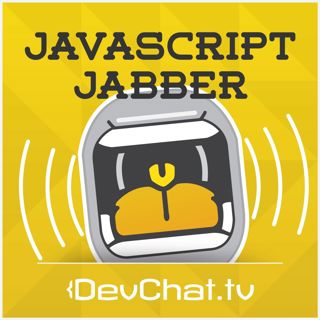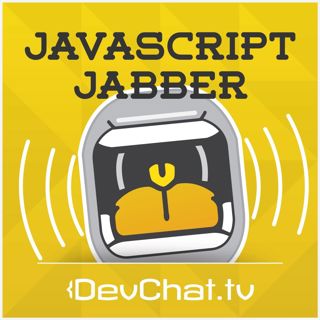
TypeScript, Security, and Type Juggling with Ariel Shulman & Liran Tal - JSJ 679
In this episode, we dove headfirst into the swirling waters of TypeScript, its real-world use cases, and where it starts to fall short—especially when it comes to security. Joining us from sunny Tel Aviv (and a slightly cooler Portland), we had the brilliant Ariel Shulman and security advocate Liran Tal bring the heat on everything from type safety to runtime vulnerabilities.We started off with a friendly debate: Has TypeScript really taken over the world? Our verdict? Pretty much. Whether it’s starter projects, enterprise codebases, or AI-generated snippets, TypeScript has become the de facto standard. But as we quickly found out, that doesn’t mean it’s perfect.Key Takeaways:-TypeScript ≠ SecurityWe tend to trust TypeScript a bit too much. It’s a build-time tool, not a runtime enforcer. As Liran pointed out, “TypeScript is not a security tool,” and treating it like one leads to dangerous assumptions.-Type Juggling is Real (and Sneaky)We explored how something as innocent as using as string on request data can open the door to vulnerabilities like HTTP parameter pollution and prototype pollution. Just because your IDE is happy doesn’t mean your runtime is.-Enter Zod – Runtime Type Checking to the Rescue?Zod got some love for bridging the dev-time/runtime gap by validating data on the fly and inferring TypeScript types. But even Zod isn’t foolproof. For example, unless you're using .strict(), extra fields can sneak past your validations, leading to mass assignment bugs.-Common Developer FallaciesWe discussed the misplaced confidence developers have in things like code coverage and TypeScript alone. One of the big takeaways: defense in depth matters. Just like testing, layering your security practices (like using Zod, type guards, and proper sanitization) is key.-TypeScript Best Practices Are EvolvingFrom discriminated unions to avoiding any, from using Maps over plain objects to prevent prototype pollution—TypeScript developers are adapting. And tools like modern Node.js now support type stripping, which makes working with .ts files at runtime a bit easier.Become a supporter of this podcast: https://www.spreaker.com/podcast/javascript-jabber--6102064/support.
29 Touko 1h 32min

Building Agentic AI Workflows with Matthew Henage - JSJ 678
In this episode, we sat down with full-stack developer and AI innovator Matthew Henage, creator of WAOS.ai (Web App Operating System) and the incredible storytelling platform SpeakMagic.ai. This conversation took us deep into the world of agentic AI, low-code app building, and the future of intelligent workflows.We kicked things off with Matthew sharing how he’s been riding the AI wave since GPT-3.5 blew his mind. His platform WoWs is all about making it easy for developers to build powerful web apps with embedded AI workflows — think of it like Zapier meets ChatGPT, but with agents working together instead of API chains.One of the most eye-opening parts of our chat was learning about agent swarms — essentially teams of specialized AI agents that collaborate to perform complex tasks. Instead of relying on one giant AI brain to do everything, you create smaller, purpose-built AIs that handle specific steps in a workflow. It’s scalable, smarter, and kind of like assembling your dream dev team… but all made of code.Matthew’s Speak Magic project is a jaw-dropper. It uses a swarm of over 40 agents to turn a single story idea into a fully animated, two-minute video — complete with scenes, scripts, character animations, music, and more. It’s AI storytelling on steroids.We also talked a lot about:Best practices for building reliable AI workflowsThe importance of keeping context windows small (under 4,000 tokens works best!)How prompt engineering is becoming the new programmingUsing AI for vibe coding (yes, that’s a thing) and rapid prototypingThe tradeoffs between using traditional programming vs. letting AI handle logicEthical considerations and how to handle memory and privacy in long-running user interactionsCheck out Matthew’s work at WAOS.ai and speakmagic.ai — and as always, stay curious and keep building!Become a supporter of this podcast: https://www.spreaker.com/podcast/javascript-jabber--6102064/support.
22 Touko 1h 3min

Reinventing Web Development with Brisa: A Conversation with Aral Roca - JSJ 677
In this week’s episode, it’s just me — Charles Max Wood — and I’m joined by the incredibly sharp and open-source-loving Aral Roca, direct from Barcelona! Aral’s the creator of Brisa, a new full-stack web framework that flips the script on how we build modern web apps. If you thought the "another day, another framework" meme was played out... well, Brisa might just change your mind.Key Takeaways:-Brisa’s Big Idea: It's designed to let you build web apps with minimal or zero JavaScript on the client side. Think HTML streaming, server actions, and components that render server-side first, but can gradually hydrate on the client.-Server-first FTW: Aral walks us through how Brisa handles server actions — even capturing click and scroll events on the server — using ideas inspired by HTMX, LiveView, and server components from frameworks like Next.js.-Tiny and Mighty: The whole framework is incredibly lightweight. Web components come in at just ~3 KB, and the built-in i18n system is under 1 KB!-From Idea to Reality: Aral started Brisa to scratch his own itch — building side projects and blogs without bloated front-end code. But now, others are using it too (yes, even in production!), including one travel agency that's gone all-in.-Multi-platform Future: Brisa has adapters in the works for Vercel, Node, and Deno — plus integration with Tauri for building native Android, iOS, and desktop apps from the same codebase.-What's Coming: Roadmap goals include improved hot reloads, more adapters, transitions, lazy-loaded components, and a better playground for developers to tinker with.Oh, and yes — Aral does parkour. For real.This episode is packed with deep technical insight and exciting potential for a new way to build web apps — especially for devs who love fast performance, server-rendering, and clean architecture.Become a supporter of this podcast: https://www.spreaker.com/podcast/javascript-jabber--6102064/support.
15 Touko 1h 5min

Building Enterprise Infrastructure with Bit & AI with Gilad Shoham - JSJ 676
In this episode, I (Steve Edwards) flew solo on the mic but had the pleasure of hosting a truly insightful conversation with Gilad Shoham, VP of Engineering at Bit.Cloud. Gilad brought the heat from Israel as we explored how Bit is revolutionizing enterprise software architecture—and how AI is being layered on top to supercharge developer productivity.We started by breaking down Bit’s core platform, which helps teams compose applications from reusable, independently versioned components. Think Lego blocks, but for your codebase. It’s all about boosting dev velocity, reducing duplication, and making collaboration across teams more seamless.Gilad walked us through some jaw-dropping features: versioning without Git, deep component CI pipelines, and even Bit’s ability to replace monolithic repositories with a graph of decoupled components. Everything is Node + TypeScript under the hood, and while it’s currently JS-focused, the ambition is clearly broader.Then came the big twist: AI. Bit is now leveraging AI not to just write code, but to compose it using existing components. Instead of bloating your codebase with endless variations of the same button, Bit’s AI understands your graph and builds features by intelligently reusing what’s already there. It’s like Copilot with a memory—and architectural sense.Key takeaways:Bit components wrap your existing code (like React/Vue) with metadata, testing, and versioning.Their infrastructure makes it possible to build and test components independently and in parallel.The AI strategy is reuse-first: generate only when needed, always compose from what already exists.Even massive enterprise codebases can gradually migrate to Bit without a full rewrite.Expect a human-in-the-loop process, but with most of the heavy lifting handled by AI.Become a supporter of this podcast: https://www.spreaker.com/podcast/javascript-jabber--6102064/support.
8 Touko 58min

Replacing Create React App: Why Create TS Router App Is the Future of React Development - JSJ 675
We’ve been diving into the evolving landscape of React app development and why tools like Create TS Router App (CTA) are stepping up to fill the gap left by the deprecation of Create React App (CRA). What we’ve learned is that SSR (server-side rendering) isn’t one-size-fits-all—e-commerce sites need it for SEO and performance, but internal tools and dashboards often don’t. That’s where CTA shines. It gives us a fast, modern, Vite-powered setup with TanStack Router built in, so we can start small and scale up without committing to heavy frameworks like Next.js from day one.What we love about CTA is how it keeps things familiar (same structure as CRA) while giving us type safety, file-based routing, and the flexibility to add only the features we need—like Clerk, Sentry, or even SolidJS support. Whether we’re building a simple prototype or a full-featured app, CTA makes the experience smoother, more intuitive, and future-friendly.Become a supporter of this podcast: https://www.spreaker.com/podcast/javascript-jabber--6102064/support.
2 Touko 1h 30min

Empowering Devs and Innovators: Inside Vercel’s Impact, Feature Flags, and the Rise of v0 - JsJ 674
In this episode, Lee Robinson, who works at Vercel, discusses the company’s impact on web development despite its relatively small size. He explains their approach to empowering small, founder-led teams to build impactful tools, highlighting their new open-source Flags SDK. They also discuss the importance of server-side feature flagging to improve performance and reduce UI shifts, while warning against exposing sensitive data through client-side experimentation. The conversation then shifts to Vercel’s internal innovation culture, particularly the development of v0, an AI-driven tool for building full-stack web applications quickly, which is especially accessible for non-developers with creative ideas.Become a supporter of this podcast: https://www.spreaker.com/podcast/javascript-jabber--6102064/support.
21 Huhti 1h 22min

Building 50 Apps in 50 Days: The Power of Boring Stacks with Kelvin - JsJ_673
In this episode, we dive into an engaging conversation with Kelvin, where we explore his approach to full-stack JavaScript development and the power of using simple, stable technologies to speed up app development.Kelvin shares his exciting project, "Project 50," where he’s challenging himself to build 50 apps in 50 days, highlighting the importance of leveraging "boring" stacks to streamline the development process. We also touch on his journey in teaching web development through free resources and screencasts, aiming to make it easier for developers to build real-world apps quickly. Along the way, we discuss the value of strategy games like chess and Go, and how they help foster critical thinking and continuous learning. It’s a great mix of tech, strategy, and entertainment, making this episode a must-listen for developers and anyone looking to level up their skills. Tune in for a fun and insightful discussion!Become a supporter of this podcast: https://www.spreaker.com/podcast/javascript-jabber--6102064/support.
14 Huhti 1h

Breaking Into Tech: Lessons from My Career Path - JsJ 672
This episode is a little different—thanks to a U.S. holiday, I’m flying solo. But that just means we get to have a one-on-one chat!I dive into my career journey—not to brag, but to offer insights for anyone feeling stuck, of how my inventor grandfather sparked my early interest in tech, how I transitioned from electrical engineering to computer engineering, and how I went from IT support to discovering my love for programming while solving real-world problems at Mosey with Ruby on Rails.Become a supporter of this podcast: https://www.spreaker.com/podcast/javascript-jabber--6102064/support.
7 Huhti 44min






















